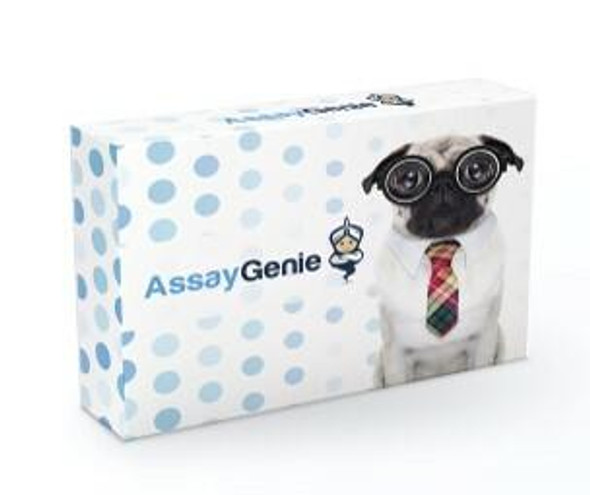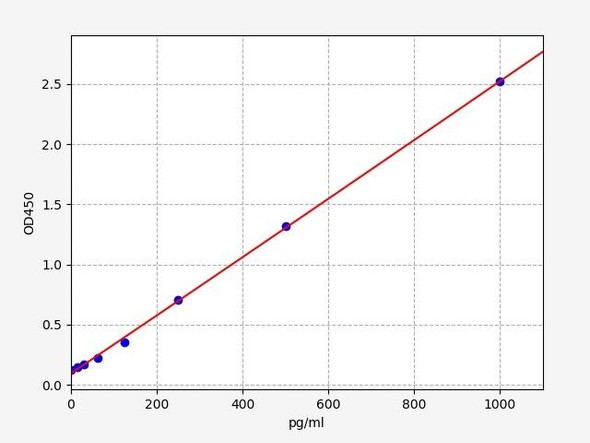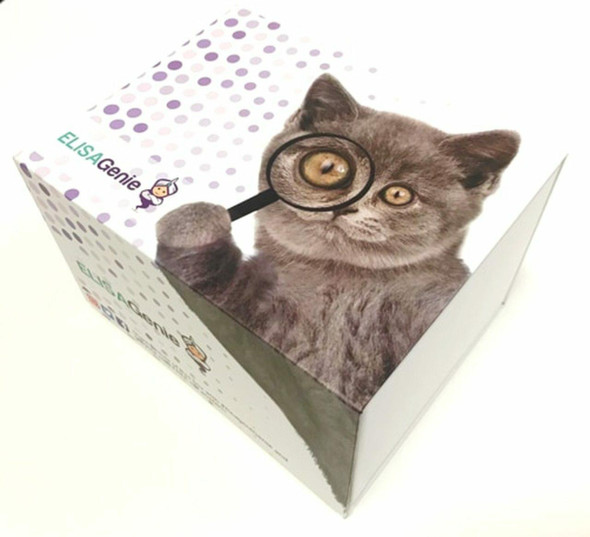Rat EGF ELISA Kit (RTFI00013)
- SKU:
- RTFI00013
- Product Type:
- ELISA Kit
- Size:
- 96 Assays
- Uniprot:
- P07522
- Sensitivity:
- 2.344pg/ml
- Range:
- 3.906-250pg/ml
- ELISA Type:
- Sandwich
- Synonyms:
- EGF, URG, HOMG4, Beta-Urogastrone, Epidermal growth factor
- Reactivity:
- Rat
Description
Rat EGF ELISA Kit
The Rat EGF (Epidermal Growth Factor) ELISA Kit is specifically designed for the quantitative detection of EGF levels in rat serum, plasma, and cell culture supernatants. With its high sensitivity and specificity, this kit provides accurate and reliable results, making it ideal for various research applications.EGF is a key growth factor that plays a vital role in cell growth, proliferation, and differentiation. It is involved in numerous physiological processes, including tissue development, wound healing, and immune response.
Dysregulation of EGF signaling has been implicated in various diseases, such as cancer, diabetes, and neurological disorders, highlighting the importance of EGF as a potential biomarker for studying these conditions.Overall, the Rat EGF ELISA Kit offers a valuable tool for researchers studying EGF biology and its implications in disease pathology, providing essential insights for developing novel therapeutic interventions. Visit www.assaygenie.com/rat-egf-elisa-kit/ for more information and to purchase the kit.
| Product Name: | Rat EGF ELISA Kit |
| Product Code: | RTFI00013 |
| Size: | 96 Assays |
| Target: | Rat EGF |
| Alias: | EGF, URG, HOMG4, Beta-Urogastrone, Epidermal growth factor |
| Reactivity: | Rat |
| Detection Method: | Sandwich ELISA, Double Antibody |
| Sensitivity: | 2.344pg/ml |
| Range: | 3.906-250pg/ml |
| Storage: | 4°C for 6 months |
| Note: | For Research Use Only |
| Recovery: | Matrices listed below were spiked with certain level of Rat EGF and the recovery rates were calculated by comparing the measured value to the expected amount of Rat EGF in samples. | ||||||||||||||||
| |||||||||||||||||
| Linearity: | The linearity of the kit was assayed by testing samples spiked with appropriate concentration of Rat EGF and their serial dilutions. The results were demonstrated by the percentage of calculated concentration to the expected. | ||||||||||||||||
| |||||||||||||||||
| Intra-Assay: | CV <8% | ||||||||||||||||
| Inter-Assay: | CV <10% |
| Uniprot: | P07522 |
| UniProt Protein Function: | EGF: EGF stimulates the growth of various epidermal and epithelial tissues in vivo and in vitro and of some fibroblasts in cell culture. Magnesiotropic hormone that stimulates magnesium reabsorption in the renal distal convoluted tubule via engagement of EGFR and activation of the magnesium channel TRPM6. Defects in EGF are the cause of hypomagnesemia type 4 (HOMG4); also known as renal hypomagnesemia normocalciuric. HOMG4 is a disorder characterized by massive renal hypomagnesemia and normal levels of serum calcium and calcium excretion. Clinical features include seizures, mild-to mederate psychomotor retardation, and brisk tendon reflexes. 2 isoforms of the human protein are produced by alternative splicing. |
| UniProt Protein Details: | Protein type:Ligand, receptor tyrosine kinase; Membrane protein, integral; Hormone Cellular Component: extracellular space; lysosomal membrane; plasma membrane; integral to membrane; intracellular Molecular Function:growth factor activity; calcium ion binding; epidermal growth factor receptor binding Biological Process: epidermal growth factor receptor signaling pathway; peptidyl-tyrosine phosphorylation; positive regulation of mitosis; activation of MAPKK activity; positive regulation of transcription, DNA-dependent; regulation of protein transport; positive regulation of MAP kinase activity; regulation of protein secretion; positive regulation of epidermal growth factor receptor activity; branching morphogenesis of a tube; positive regulation of cell proliferation; negative regulation of secretion; angiogenesis; regulation of peptidyl-tyrosine phosphorylation; positive regulation of phosphorylation; positive regulation of DNA binding; STAT protein nuclear translocation; positive regulation of granule cell precursor proliferation |
| NCBI Summary: | binds the epidermal growth factor receptor; may play a role in MAP kinase mediated signaling pathways [RGD, Feb 2006] |
| UniProt Code: | P07522 |
| NCBI GenInfo Identifier: | 1352360 |
| NCBI Gene ID: | 25313 |
| NCBI Accession: | P07522.2 |
| UniProt Secondary Accession: | P07522,Q63183, |
| UniProt Related Accession: | P07522 |
| Molecular Weight: | 124,126 Da |
| NCBI Full Name: | Pro-epidermal growth factor |
| NCBI Synonym Full Names: | epidermal growth factor |
| NCBI Official Symbol: | Egf |
| NCBI Protein Information: | pro-epidermal growth factor |
| UniProt Protein Name: | Pro-epidermal growth factor |
| Protein Family: | EGF-like domain containing protein |
| UniProt Gene Name: | Egf |
| UniProt Entry Name: | EGF_RAT |
| Step | Procedure |
| 1. | Set standard, test sample and control (zero) wells on the pre-coated plate respectively, and then, record their positions. It is recommended to measure each standard and sample in duplicate. Wash plate 2 times before adding standard, sample and control (zero) wells! |
| 2. | Aliquot 0.1ml standard solutions into the standard wells. |
| 3. | Add 0.1 ml of Sample / Standard dilution buffer into the control (zero) well. |
| 4. | Add 0.1 ml of properly diluted sample ( Human serum, plasma, tissue homogenates and other biological fluids.) into test sample wells. |
| 5. | Seal the plate with a cover and incubate at 37°C for 90 min. |
| 6. | Remove the cover and discard the plate content, clap the plate on the absorbent filter papers or other absorbent material. Do NOT let the wells completely dry at any time. Wash plate X2. |
| 7. | Add 0.1 ml of Biotin- detection antibody working solution into the above wells (standard, test sample & zero wells). Add the solution at the bottom of each well without touching the side wall. |
| 8. | Seal the plate with a cover and incubate at 37°C for 60 min. |
| 9. | Remove the cover, and wash plate 3 times with Wash buffer. Let wash buffer rest in wells for 1 min between each wash. |
| 10. | Add 0.1 ml of SABC working solution into each well, cover the plate and incubate at 37°C for 30 min. |
| 11. | Remove the cover and wash plate 5 times with Wash buffer, and each time let the wash buffer stay in the wells for 1-2 min. |
| 12. | Add 90 µL of TMB substrate into each well, cover the plate and incubate at 37°C in dark within 10-20 min. (Note: This incubation time is for reference use only, the optimal time should be determined by end user.) And the shades of blue can be seen in the first 3-4 wells (with most concentrated standard solutions), the other wells show no obvious color. |
| 13. | Add 50 µL of Stop solution into each well and mix thoroughly. The color changes into yellow immediately. |
| 14. | Read the O.D. absorbance at 450 nm in a microplate reader immediately after adding the stop solution. |
When carrying out an ELISA assay it is important to prepare your samples in order to achieve the best possible results. Below we have a list of procedures for the preparation of samples for different sample types.
| Sample Type | Protocol |
| Serum: | If using serum separator tubes, allow samples to clot for 30 minutes at room temperature. Centrifuge for 10 minutes at 1,000x g. Collect the serum fraction and assay promptly or aliquot and store the samples at -80°C. Avoid multiple freeze-thaw cycles. If serum separator tubes are not being used, allow samples to clotovernight at 2-8°C. Centrifuge for 10 minutes at 1,000x g. Removeserum and assay promptly or aliquot and store the samples at-80°C. Avoid multiple freeze-thaw cycles. |
| Plasma: | Collect plasma using EDTA or heparin as an anti-coagulant. Centrifuge samples at 4°C for 15 mins at 1000 × g within 30 mins of collection. Collect the plasma fraction and assay promptly or aliquot and store the samples at -80°C. Avoid multiple freeze-thaw cycles.Note: Over haemolysed samples are not suitable for use with this kit. |
| Urine & Cerebrospinal Fluid: | Collect the urine (mid-stream) in a sterile container, centrifuge for 20 mins at 2000-3000 rpm. Remove supernatant and assay immediately. If any precipitation is detected, repeat the centrifugation step. A similar protocol can be used for cerebrospinal fluid. |
| Cell Culture Supernatant: | Collect the cell culture media by pipette, followed by centrifugation at 4°C for 20 mins at 1500 rpm. Collect the clear supernatant and assay immediately. |
| Cell Lysates: | Solubilize cells in lysis buffer and allow to sit on ice for 30 minutes. Centrifuge tubes at 14,000 x g for 5 minutes to remove insoluble material. Aliquot the supernatant into a new tube and discard the remaining whole cell extract. Quantify total protein concentration using a total protein assay. Assay immediately or aliquot and store at ≤ -20°C. |
| Tissue Homogenates: | The preparation of tissue homogenates will vary depending upon tissue type. Rinse tissue with 1X PBS to remove excess blood & homogenizein 20ml of 1X PBS (including protease inhibitors) and store overnight at ≤ -20°C. Two freeze-thaw cycles are required to break the cell membranes. To further disrupt the cell membranes you can sonicate the samples. Centrifuge homogenates for 5 mins at 5000xg. Remove the supernatant and assay immediately or aliquot and store at -20°C or-80°C. |
| Tissue Lysates: | Rinse tissue with PBS, cut into 1-2 mm pieces, and homogenize with a tissue homogenizer in PBS. Add an equal volume of RIPA buffer containing protease inhibitors and lyse tissues at room temperature for 30 minutes with gentle agitation. Centrifuge to remove debris. Quantify total protein concentration using a total protein assay. Assay immediately or aliquot and store at ≤ -20 °C. |
| Breast Milk: | Collect milk samples and centrifuge at 10,000 x g for 60 min at 4°C. Aliquot the supernatant and assay. For long term use, store samples at -80°C. Minimize freeze/thaw cycles. |






